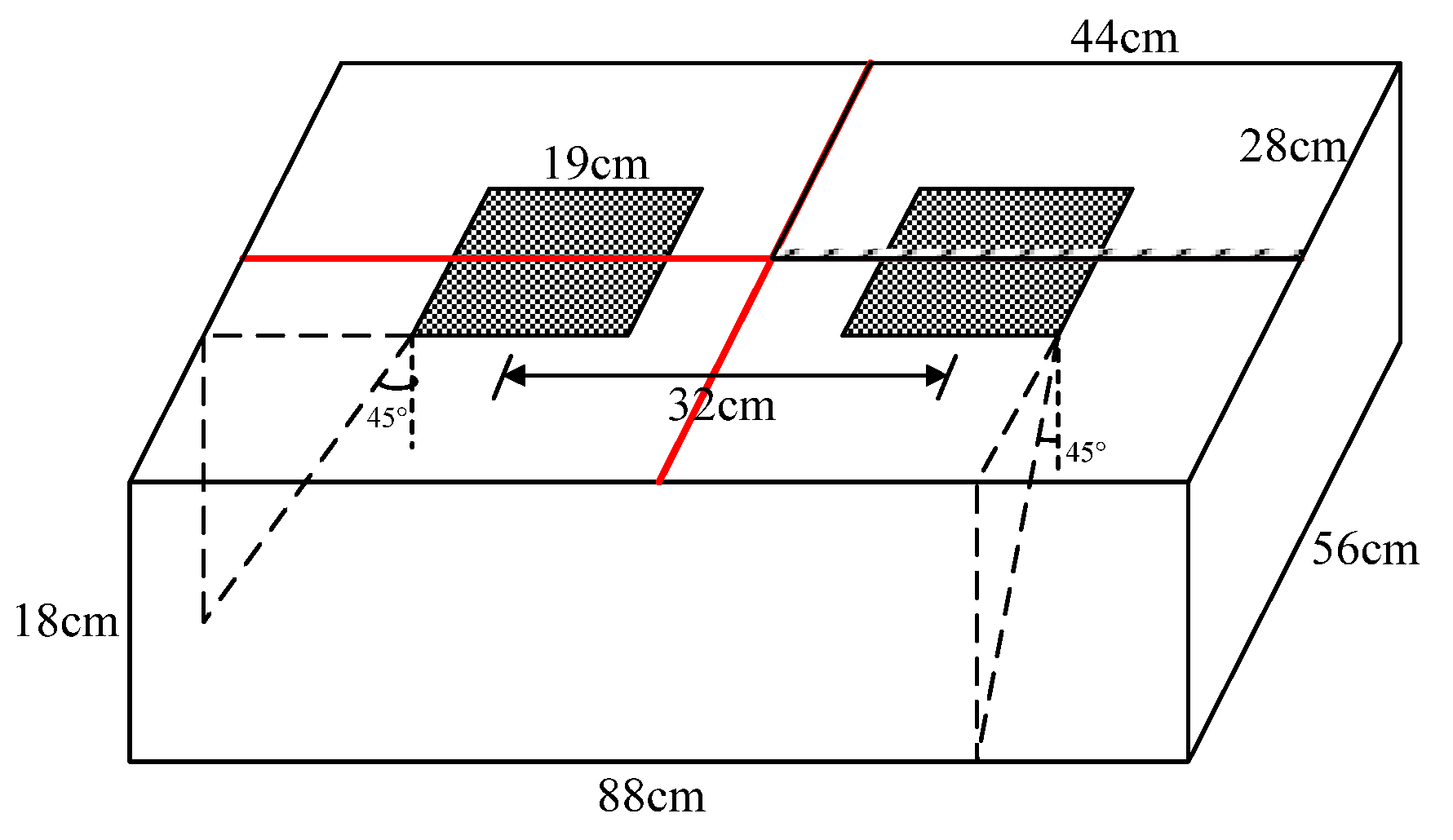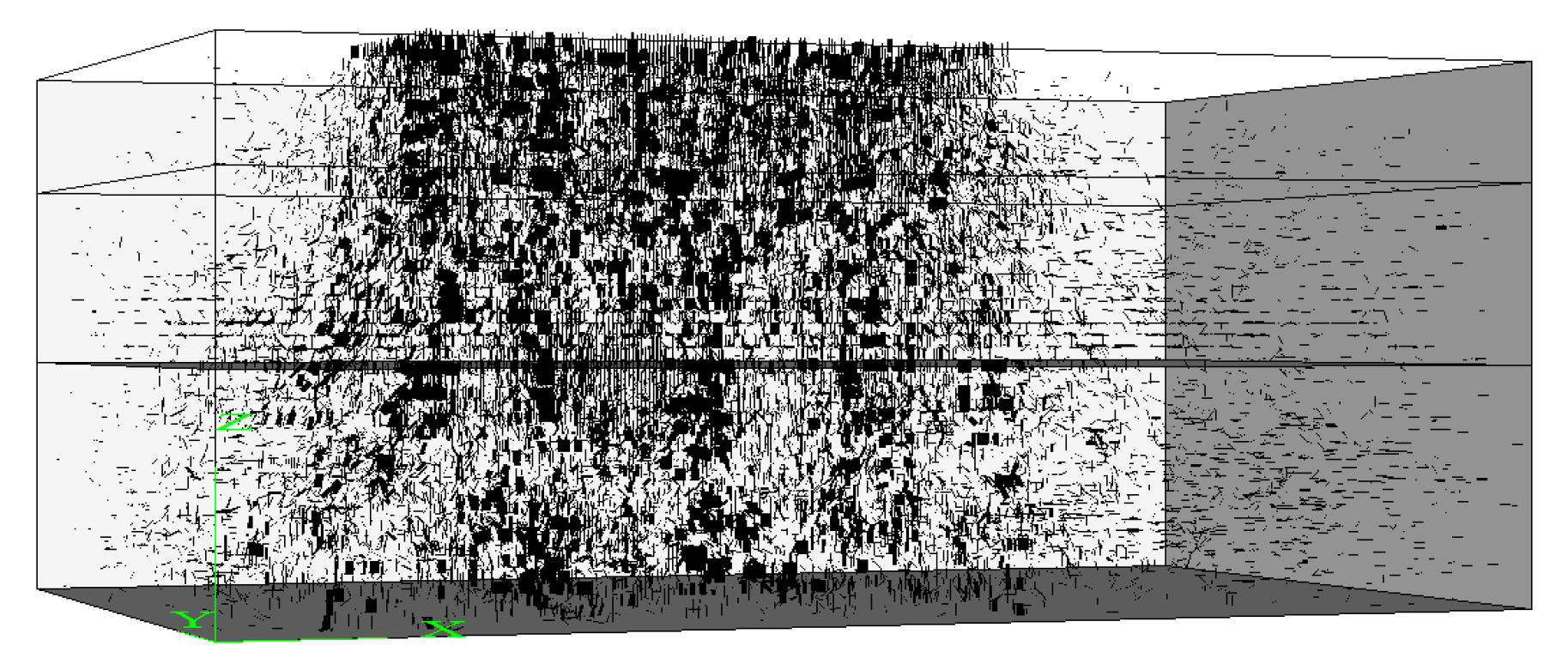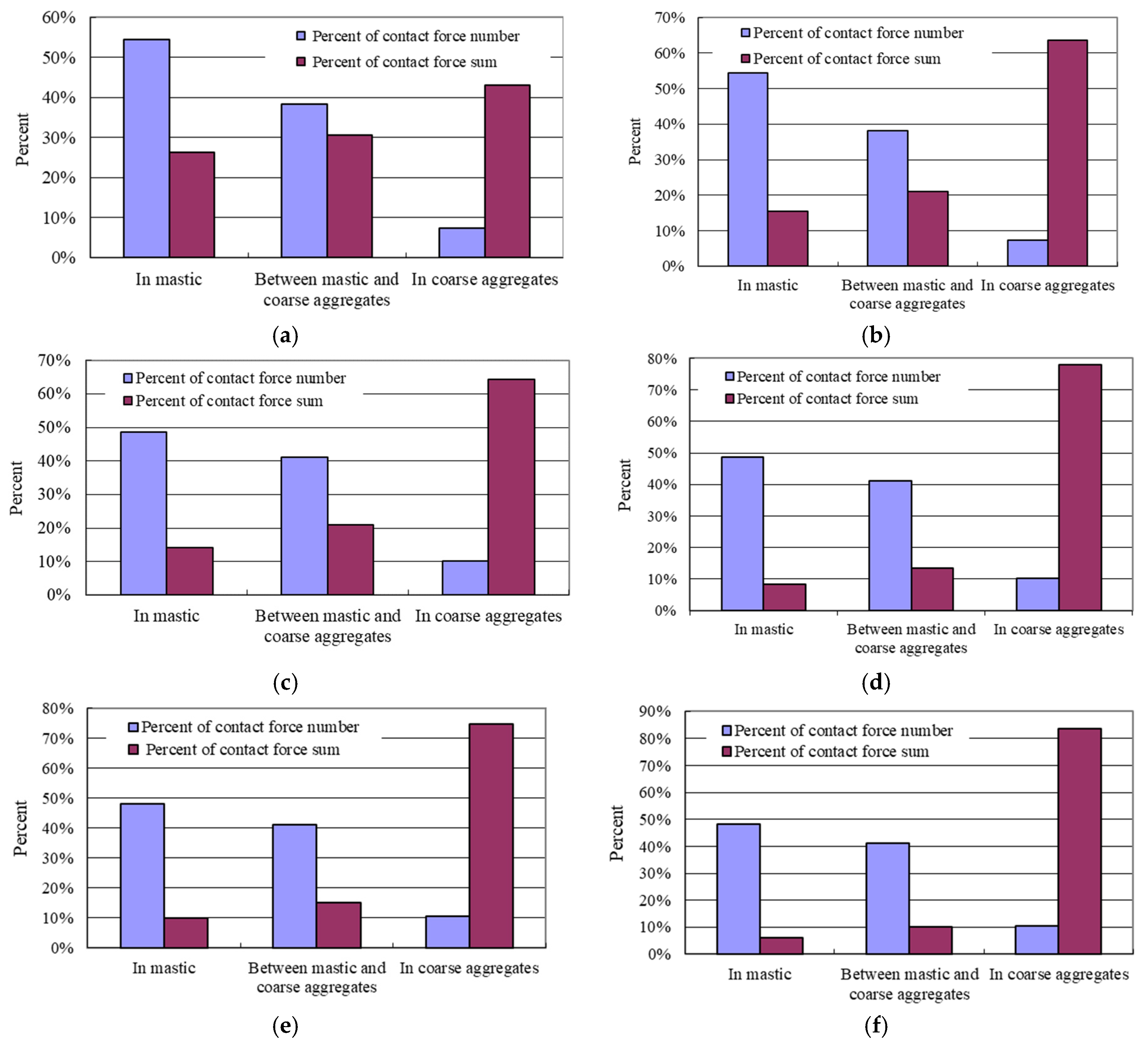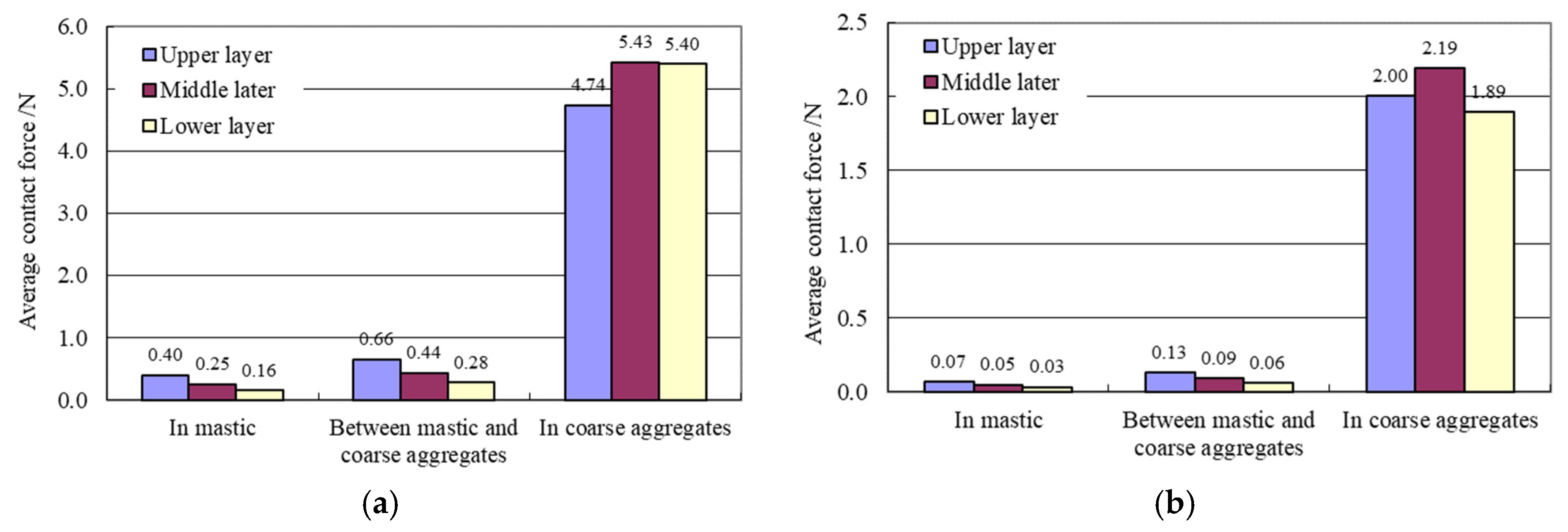Discrete Element Modeling of the Meso-Mechanical Response of Asphalt Pavement under Vehicle Load
Abstract
:1. Introduction
2. Discrete Element Model
2.1. Reconstruction of Asphalt Mixture Meso-Structure
2.2. Pavement Structure and Parameters
2.3. Load, Model Dimensions and Boundary Conditions
3. Results and Discussion
- (1)
- Under the standard axle load, the maximum normal contact force in coarse aggregates in the upper layer can reach 378 N and in the middle and lower layer this value can reach 280 N. The maximum tangential contact force in coarse aggregates in the upper layer can reach 121 N and in the middle and lower layer this value is 110 N. Hou et al. [33] studied the micro-mechanical response of asphalt mixtures by the DEM. In their study, a reduced model with a length of 15 cm, a width of 15 cm and a thickness of 6 cm was used and the load area in the model was reduced proportionally. The maximum contact force is between 80 N and 90 N within the model under the vehicle load of 0.7 Mpa. This demonstrates that simulation with reduced models may give wrong calculation results. Full-scale model is necessary in the discrete element simulation.
- (2)
- The maximum normal contact force and the maximum tangential contact force in asphalt mastic and between asphalt mastic and coarse aggregates are at the same magnitude order. The maximum normal contact force is one order of magnitude lower than the maximum contact force in coarse aggregates. The maximum tangential contact force is two orders of magnitude lower than that value in coarse aggregates. The maximum normal contact force and the maximum tangential contact force between coarse aggregates and asphalt mastic in each layer are, respectively, about twice the maximum normal contact force and the maximum tangential contact force in asphalt mastic.
- (3)
- As can be seen from Figure 5, most of the contact forces are lower than 10 N. The percent of the normal contact forces that exceed 10 N is between 1.0% and 1.4% in each layer. The percent of the tangential contact forces that exceed 10 N is between 0.4% and 0.6%.
- (1)
- The normal and tangential contact forces in the middle and the lower layer have similar distribution patterns. The normal contact forces are mainly distributed in the four intervals of (10−3 N, 10−2 N], (10−2 N, 10−1 N], (0.1 N, 1 N] and (1 N, 10 N). More than 75% of the normal contact forces lie in the interval (10−2 N, 10−1 N] and (0.1 N, 1 N). The tangential contact forces are mainly distributed in the intervals of (10−3 N, 10−2 N], (10−2 N, 10−1 N] and (0.1 N, 1 N). More than 42% of the tangential contact forces lie in the interval (10−2 N, 10−1 N).
- (2)
- The upper layer has more contact forces in the smaller value range than the middle and the lower layer. The normal contact forces are mainly distributed in the four intervals of (10−3 N, 10−2 N], (10−2 N, 10−1 N], (0.1 N, 1 N] and (1 N, 10 N). The normal contact forces that in the interval (10−2 N, 10−1 N) occupy 37% of all contact forces in the upper layer. The tangential contact forces are mainly distributed in the interval (10−4 N, 10−3 N], (10−3 N, 10−2 N], (10−2 N, 10−1 N] and (0.1 N, 1 N), with (10−2 N, 10−1 N) the highest.
- (1)
- In each layer, the number of contact forces in asphalt mastic accounts for about 50%, the number of contact forces between coarse aggregates and asphalt mastic accounts for about 40%, and the number of contact forces in coarse aggregates accounts for only about 10%.
- (2)
- In the upper layer, the sum of the normal contact forces in coarse aggregates accounts for about 43% and the sum of the tangential contact forces accounts for about 64%. In the middle layer, the sum of the normal contact forces in coarse aggregates is about 64% and the sum of the tangential contact forces is about 78%. In the lower layer, the sum of the normal contact forces in coarse aggregates is about 75% and the sum of the tangential contact forces in coarse aggregates is about 84%.
- (3)
- The above data indicates that the wheel load transmitted to the asphalt surface layer is mainly born by the coarse aggregates in each layer. A similar conclusion was also got by the study of Hou et al. [33]. Since the proportion of coarse aggregates in the AC-13 mixture of the upper layer is relatively low and AC-13 has a typical suspended-dense structure, the percent of the normal contact forces and the tangential contact forces in coarse aggregates in the upper layer is lower than that in the middle and the lower layers. Compared to the study of Hou et al. [33], this study further reveals the bearing characteristics of asphalt pavement due to that a three-layer asphalt pavement model was used in the simulation.
- (1)
- Under the standard axle load, the average normal contact force in coarse aggregates in all layers is about 5 N and the average tangential contact force is about 2 N. Ma et al. [31] simulated the wheel tracking test of asphalt mixtures with a three-dimensional micromechanical discrete element model. In their study, the average contact force within the aggregate skeleton was monitored. The results show that the average contact force is between 1.5 N and 2 N which is smaller than that computed by this study. The difference is caused by the model sizes and loading area. The average normal contact force between coarse aggregates and asphalt mastic in all layers lies between 0.2 N and 0.7 N and the average tangential contact force is between 0.05 N and 0.15 N. The average normal contact force in asphalt mastic in all layers is between 0.1 N and 0.5 N and the average tangential contact force is between 0.03 N and 0.07 N.
- (2)
- In each layer, the average normal contact force and the average tangential contact force in coarse aggregates are much larger than those in asphalt mastic and between coarse aggregates and asphalt mastic. This further proves that coarse aggregates are the main load bearing component in each layer.
- (3)
- The average normal contact force in coarse aggregates show very little difference among the upper, the middle and the lower layer. So are the average tangential contact force. This shows that all three layers of the asphalt pavement are the main bearers of the wheel load. This is consistent with the conclusions obtained from Figure 4.
- (4)
- In each layer, the average contact force at different positions is significantly different. This proves that the internal contact forces of the asphalt mixture under load are highly uneven.
4. Conclusions
Author Contributions
Funding
Institutional Review Board Statement
Informed Consent Statement
Data Availability Statement
Conflicts of Interest
References
- Gungor, O.E.; AL-Qadi, I.L.; Gamez, A.; Hernandez, J.A. In-Situ Validation of Three-Dimensional Pavement Finite Element Models; Springer International Publishing: Amsterdam, The Netherlands; Berlin/Heidelberg, Germany, 2016. [Google Scholar]
- Assogba, O.C.; Sun, Z.; Tan, Y.; Nonde, L. Finite-element simulation of instrumented asphalt pavement response under moving vehicular load. Int. J. Geomech. 2020, 20, 04020006. [Google Scholar] [CrossRef]
- Wang, H.; Li, M.; Garg, N.; Zhao, J. Multi-wheel gear loading effect on load-induced failure potential of airfield flexible pavement. Int. J. Pavement Eng. 2020, 21, 805–816. [Google Scholar] [CrossRef]
- Zhang, Y.; Gu, F.; Luo, X.; Birgisson, B.; Lytton, R.L. Modeling stress-dependent anisotropic elastoplastic unbound granular base in flexible pavements. Transp. Res. Rec. 2018, 2672, 45–56. [Google Scholar] [CrossRef]
- Lu, G.; Wang, H.; Törzs, T.; Liu, P.; Zhang, Y.; Wang, D.; Oeser, M.; Grabe, J. In-situ and numerical investigation on the dynamic response of unbounded granular material in permeable pavement. Transp. Geotech. 2020, 163, 100396. [Google Scholar] [CrossRef]
- Aragão, F.T.S.; Kim, Y.R.; Lee, J.; Allen, D.H. Micromechanical model for heterogeneous asphalt concrete mixtures subjected to fracture failure. J. Mater. Civ. Eng. 2011, 23, 30–38. [Google Scholar] [CrossRef]
- Wang, H.; Zhang, C.; Yang, L.; You, Z. Study on the rubber-modified asphalt mixtures’ cracking propagation using the extended finite element method. Constr. Build. Mater. 2013, 47, 223–230. [Google Scholar] [CrossRef]
- Ng, K.; Dai, Q. Investigation of fracture behavior of heterogeneous infrastructure materials with extended-finite-element method and image analysis. J. Mater. Civ. Eng. 2011, 23, 1662–1671. [Google Scholar] [CrossRef]
- Masad, E.; Tashman, L.; Somedavan, N.; Little, D. Micromechanics-based analysis of stiffness anisotropy in asphalt mixtures. J. Mater. Civ. Eng. 2002, 14, 374–383. [Google Scholar] [CrossRef]
- Yin, A.; Yang, X.; Zeng, G.; Gao, H. Fracture simulation of pre-cracked heterogeneous asphalt mixture beam with movable three-point bending load. Constr. Build. Mater. 2014, 65, 232–242. [Google Scholar] [CrossRef]
- Soares, J.B.; de Freitas, F.A.C.; Allen, D.H. Considering material heterogeneity in crack modeling of asphaltic mixtures. Transp. Res. Rec. 2003, 1832, 113–120. [Google Scholar] [CrossRef]
- Peng, Y.; Sun, L. Horizontal homogeneity in laboratory-compacted asphalt specimens. Road Mater. Pavement Des. 2014, 15, 911–924. [Google Scholar] [CrossRef]
- Cundall, P.A. A computer model for simulating progressive large-scale movements in blocky rock systems. In Proceedings of the International Symposium on Rock Fracture, Nancy, France, 4–6 October 1971. [Google Scholar]
- Cundall, P.A.; Strack, O.D.L. A discrete numerical model for granular assemblies. Géotechnique 1979, 29, 47–65. [Google Scholar] [CrossRef]
- Abbas, A.; Masad, E.; Papagiannakis, T.; Harman, T. Micro-mechanical modeling of the viscoelastic behavior of asphalt mixtures using the discrete-element method. Int. J. Geomech. 2007, 7, 131–139. [Google Scholar] [CrossRef]
- Liu, Y.; Dai, Q.; You, Z. Viscoelastic model for discrete element simulation of asphalt mixtures. J. Eng. Mech. 2009, 135, 324–333. [Google Scholar] [CrossRef] [Green Version]
- Buttlar, W.G.; You, Z. Discrete element modeling of asphalt concrete: Microfabric approach. Transp. Res. Rec. 2001, 1757, 111–118. [Google Scholar] [CrossRef]
- You, Z.; Buttlar, W.G. Discrete element modeling to predict the modulus of asphalt concrete mixtures. J. Mater. Civ. Eng. 2004, 16, 140–146. [Google Scholar] [CrossRef]
- Wang, L.; Frost, J.D.; Lai, J.S. Three-dimensional digital representation of granular material microstructure from X-ray tomography imaging. J. Comput. Civ. Eng. 2004, 18, 28–35. [Google Scholar] [CrossRef]
- Wang, L.; Park, J.Y.; Fu, Y. Representation of real particles for DEM simulation using X-ray tomography. Constr. Build. Mater. 2007, 21, 338–346. [Google Scholar] [CrossRef]
- Fu, Y.; Wang, L.; Tumay, M.T.; Li, Q. Quantification and simulation of particle kinematics and local strains in granular materials using X-ray tomography imaging and discrete-element method. J. Eng. Mech. 2008, 134, 143–154. [Google Scholar] [CrossRef]
- Lu, M.; McDowell, G.R. The importance of modelling ballast particle shape in the discrete element method. Granul. Matter 2007, 9, 69–80. [Google Scholar] [CrossRef]
- Zhang, D.; Huang, X.; Zhao, Y. Algorithms for generating three-dimensional aggregates and asphalt mixture samples by the discrete element method. J. Comput. Civ. Eng. 2013, 27, 111–117. [Google Scholar] [CrossRef]
- You, Z.; Buttlar, W.G. Application of discrete element modeling techniques to predict the complex modulus of asphalt-aggregate hollow cylinders subjected to internal pressure. Transp. Res. Rec. 2005, 1929, 218–226. [Google Scholar] [CrossRef]
- You, Z.; Buttlar, W.G. Micromechanical modeling approach to predict compressive dynamic moduli of asphalt mixture using the distinct element method. Transp. Res. Rec. 2006, 1970, 73–83. [Google Scholar] [CrossRef]
- You, Z.; Liu, Y.; Dai, Q. Three-dimensional microstructural-based discrete element viscoelastic modeling of creep compliance tests for asphalt mixtures. J. Mater. Civ. Eng. 2011, 23, 79–87. [Google Scholar] [CrossRef]
- Kim, H.; Wagoner, M.P.; Buttlar, W.G. Simulation of fracture behavior in asphalt concrete using a heterogeneous cohesive zone discrete element model. J. Mater. Civ. Eng. 2008, 20, 552–563. [Google Scholar] [CrossRef]
- Kim, H.; Wagoner, M.P.; Buttlar, W.G. Micromechanical fracture modeling of asphalt concrete using a single-edge notched beam test. Mater. Struct. 2009, 42, 677–689. [Google Scholar] [CrossRef]
- Kim, H.; Wagoner, M.P.; Buttlar, W.G. Numerical fracture analysis on the specimen size dependency of asphalt concrete using a cohesive softening model. Constr. Build. Mater. 2009, 23, 2112–2120. [Google Scholar] [CrossRef]
- Zhang, D.; Hou, S.; Bian, J.; He, L. Investigation of the micro-cracking behavior of asphalt mixtures in the indirect tensile test. Eng. Fract. Mech. 2016, 163, 416–425. [Google Scholar] [CrossRef]
- Ma, T.; Zhang, D.; Zhang, Y.; Hong, J. Micromechanical response of aggregate skeleton within asphalt mixture based on virtual simulation of wheel tracking test. Constr. Build. Mater. 2016, 111, 153–163. [Google Scholar] [CrossRef]
- Peng, Y.; Xia, S.; Xu, Y.R.; Lu, X.Y.; Li, Y.W. Mechanical response of asphalt surfaces under moving traffic loads using 3D discrete element method. J. Transp. Eng. Part B Pavements 2022, 148, 04022006. [Google Scholar] [CrossRef]
- Hou, S.; Zhang, D.; Huang, X.; Zhao, Y. Investigation of micro-mechanical response of asphalt mixtures by a three-dimensional discrete element model. J. Wuhan Univ. Technol.-Mater. Sci. Ed. 2015, 30, 338–343. [Google Scholar] [CrossRef]







| Layer Position | Asphalt Mixture Type | Thickness/cm | Air Void Rate/% | Asphalt Content/% |
|---|---|---|---|---|
| Upper layer | AC-13 | 4 | 3 | 6 |
| Middle layer | AC-20 | 6 | 4 | 5 |
| Lower layer | AC-25 | 8 | 5 | 5 |
| Sieve Size/mm | 31.5 | 26.5 | 19 | 16 | 13.2 | 9.5 | 4.75 | |
|---|---|---|---|---|---|---|---|---|
| Passing rate/% | AC-13 | 100 | 100 | 100 | 100 | 95 | 76.5 | 53 |
| AC-20 | 100 | 100 | 95 | 85 | 71 | 61 | 41 | |
| AC-25 | 100 | 95 | 82.5 | 74 | 66.5 | 55 | 38 | |
| Category | Balls in Coarse Aggregates | Balls in Asphalt Mastic | Parallel-Bond Model | ||||||
|---|---|---|---|---|---|---|---|---|---|
| Parameter | kn | ks | kn | ks | pb_kn | pb_ks | pb_nstr | pb_sstr | pb_radius |
| Unit | N/m | N/m | N/m | N/m | N/m3 | N/m3 | Pa | Pa | mm |
| Value | 4.4 × 108 | 2.0 × 108 | 4.0 × 106 | 1.33 × 106 | 2.5 × 1011 | 2.34 × 1010 | 1.2 × 106 | 1.2 × 106 | 0.5 |
| Position | Values (N) | |||||
|---|---|---|---|---|---|---|
| In Normal Direction | In Tangential Direction | |||||
| In Mastic | Between Coarse Aggregates and Mastic | In Coarse Aggregates | In Mastic | Between Coarse Aggregates and Mastic | In Coarse Aggregates | |
| Upper layer | 14.9 | 32.6 | 378 | 3.34 | 5.13 | 121 |
| Middle later | 10.8 | 18.3 | 282 | 2.1 | 4.99 | 106 |
| Lower layer | 7.06 | 17 | 280 | 1.87 | 2.67 | 113 |
Publisher’s Note: MDPI stays neutral with regard to jurisdictional claims in published maps and institutional affiliations. |
© 2022 by the authors. Licensee MDPI, Basel, Switzerland. This article is an open access article distributed under the terms and conditions of the Creative Commons Attribution (CC BY) license (https://creativecommons.org/licenses/by/4.0/).
Share and Cite
Zhang, D.; Wu, C.; Cai, L.; Bian, J.; Yin, C. Discrete Element Modeling of the Meso-Mechanical Response of Asphalt Pavement under Vehicle Load. Materials 2022, 15, 7808. https://doi.org/10.3390/ma15217808
Zhang D, Wu C, Cai L, Bian J, Yin C. Discrete Element Modeling of the Meso-Mechanical Response of Asphalt Pavement under Vehicle Load. Materials. 2022; 15(21):7808. https://doi.org/10.3390/ma15217808
Chicago/Turabian StyleZhang, Dong, Chunying Wu, Lili Cai, Jiang Bian, and Chaoen Yin. 2022. "Discrete Element Modeling of the Meso-Mechanical Response of Asphalt Pavement under Vehicle Load" Materials 15, no. 21: 7808. https://doi.org/10.3390/ma15217808
APA StyleZhang, D., Wu, C., Cai, L., Bian, J., & Yin, C. (2022). Discrete Element Modeling of the Meso-Mechanical Response of Asphalt Pavement under Vehicle Load. Materials, 15(21), 7808. https://doi.org/10.3390/ma15217808






